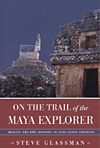

| |
| Editors' Picks | Volume 57 Number 1, January/February 2004 |
BOOKS & MULTIMEDIA:
EDITORS' PICKS

|
Megaliths (London: Random House, 2003; $55) features David Corio's handsome black-and-white photographs of both well-known and obscure ancient stone monuments in England and Wales. The accompanying text, by Corio's wife, writer Lai Ngan Corio, gracefully recounts legends and folklore associated with each site. What makes the book especially fun to read is its focus on descriptions of the sites left behind by seventeenth- and eighteenth-century antiquarians, who can always be counted on for interesting speculations, like wondering if megaliths were made by "Men of Gigantick stature." |
Search for the Earliest Americans, a NOVA special airing on PBS stations, examines the provocative theory of Smithsonian archaeologist Dennis Stanford and his colleague Bruce Bradley that Ice Age Europeans traveled in skin boats along the fringes of the Atlantic ice sheet some 16,000 years ago. According to the theory, they eventually reached North America, where their stone-working techniques evolved into the Clovis culture. New discoveries that seem to favor the theory will be publicly introduced for the first time in the program, though NOVA will also present some reasons why most archaeologists remain deeply skeptical of the hypothesis. NOVA has postponed the premiere of Search for the First Americans. Check our website and www.pbs.org/wgbh/nova/ in the near future for the new air date. |

|
Novelist Steve Glassman retraces the voyages of nineteenth-century lawyer and explorer John Lloyd Stephens through the Yucatán in On the Trail of the Maya Explorer: Tracing the Epic Journey of John Lloyd Stephens (Tuscaloosa: University of Alabama Press, 2003; $29.95). Stephens' classic account of his explorations--Incidents of Travel in Central America, Chiapas, and Yucatán, considered a masterpiece of nineteenth-century nonfiction--introduced the ancient Maya to the larger world. Glassman borrows liberally from Stephen's 200-year-old observations and modern scholarship, giving heft to his own compelling travel narrative. |
NOV/DEC PICKS | ARCHAEOLOGY's bookstore | MAR/APR PICKS
© 2004 by the Archaeological Institute of America archive.archaeology.org/0401/reviews/picks.html |
Advertisement

Advertisement






